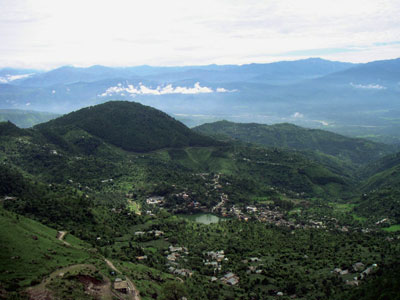
I sit in a pink plastic lawn chair in front of my borrowed meditation cave. The afternoon is perfect, a warm cedar-scented breeze sighing through the branches of the deodar cedars on the hill. Tiny birds chirp in the underbrush. My rosary drops onto my lap, my mantra recitation slurs to a halt.
Past my bare toes is a gulf of bluish, haze-softened air. Far below, the sacred lake glints like dull-green jade. The high Himalayas are visible today, low and pale across the horizon.
I’ve wanted to meditate in a cave ever since reading those first hyperbolic yoga books as a teenager. But I thought I’d be eating weeds, fighting off leopards and even a demon or two. Privation and loneliness would be the whole enlightening deal. I’d end up luminous and scrawny, wearing nothing but a diaper.
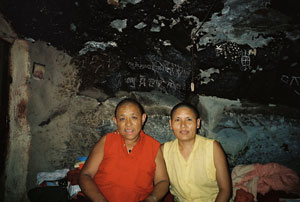
Reality, here, is quite the opposite. I’m getting fatter by the day. By the time I go home, after a month, I will have gained eight pounds. My cave has electricity and linoleum on the floor, keeping dust at bay. It’s not exactly a cave, but rather an overhang under a cliff, beefed up with a front wall, door, and curtains on the windows. The effect is reminiscent of a rustic stone house you might see in the Alps, but with bigger spiders.
Yes, I’m surrounded by mini-beings. Spiders, centipedes, flies, mosquitoes, beetles, silverfish, moths, and cockroaches. Through the pitch-black night I hear them crunching in each other’s jaws, plus the scufflings of rats, mongooses, feral cats, and snakes, fighting and mating in the crevices of the roof. Not to mention the living presence of the mountain, dropping the occasional clod onto my bed as she takes another baby step toward the sea.
These things all provide occasion for forbearance, and a tale of hardship I can tell the folks back home. But vermin and the danger of collapse aren’t the main duress of being here. It is accepting the extraordinary love I’m being given.
One night I dream of my mother, alive. She died in 1983, but I know what the dream means. I haven’t been cared for like this since I was an infant.
Three weeks ago, armed with introductions and a few small gifts, I arrived in Rewalsar, as the Indians call the lake and town a thousand meters below this cave (for Tibetans, it’s Tso Pema, “Lotus Lake”). Ani Choe Lhamo was the first person I contacted. She is a nun, about forty, and speaks a little English. We hung out. “You and me, same!” she said, laughing, the day she learned we shared a root guru, the late Dzogchen master Nyoshul Khenpo Rinpoche. A few days later she offered me her cave. I’d mentioned envying her but honestly, I didn’t mean it as a hint.
“If you or I meditate in my cave, what difference?” Then she laughed maniacally again.
But I’m cautiously in agreement that we may have been sisters in some forgotten past life. It’s a feeling. Laughing together, lying side by side on a bed eating mango sprinkled with Chunky Chat spice powder, I feel inexplicably close to her. Rationally, I tell myself this is simply what it’s like to hang out with someone who practices being unselfish, compassionate, and wise every day for years. Still, being here seems like stumbling into the arms of a long-lost, alternate family. Or maybe I don’t even have to call it alternate. It’s real, with resonances deep as blood.
“I will miss you,” she said, and walked off around the shoulder of the hill.
So my cave is full of her absence, an austere, demanding gift in its own way. I’m sleeping in her bed, sitting in her pink lawn chair gazing out at this view—while she shares a room with her 80-year-old great-uncle at a monastery down the hill.
And this is only half the story. For the cave is a duplex, and another nun lives next door: rotund, gossipy Ani Choenyi, sixty-one years old.
“My” side of the cave is slightly bigger than hers. Still, from the bed, where I usually meditate, I can reach everything without uncrossing my legs. Book, teacup, incense, light switch. It is delightful to be snuggled into the mountain’s dark stone belly, upheld by the sturdy rhythms of Ani Choenyi’s practice.
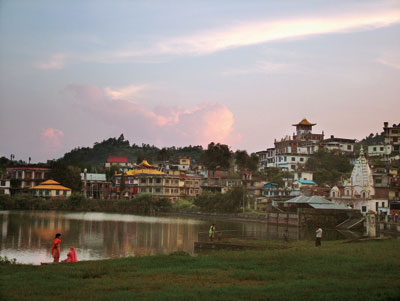
I love listening to her drum and bell, the strange wail of her thighbone trumpet that wriggles through the air as soon as darkness swallows the mountain. She is practicing Chöd, offering her body to demons, hungry ghosts, and presumably the human being next door. I know she thinks I’m hungry, given the way she feeds me during the day.
I’ve been fantasizing a lot about my life unrolling forward from here, especially when it rains and the outer world literally vanishes behind low, rolling clouds the color of dirty rags. Or when morning light comes in the window. And even when dozens of spiders spiral around the walls. Of course I know this is like a dream. I won’t be here long—very soon, my karmic debt to this community would go from overwhelming to disgraceful. Like the New Yorker cartoon of a wife coming to retrieve her husband from a similar mountaintop: “Sheldon!” For now, it’s obvious that love is the practice I am meant to be doing here. Especially since this lake is where Guru Rinpoche—the yogi who converted Tibet to Buddhism, also known as Padmasambhava—fell in love twelve hundred years back.
A few hundred yards from where I sit, he and Princess Mandarava disappeared into the stony bowels of this mountain. Though her mind was freed by their Tantric practice, it’s hardly surprising that her father, the king, got upset. There are still some pretty wild ascetics wandering around India. Just a week ago, down by the lake, I got creeped out by the coals at the bottom of a pair of eyes I’d made the mistake of looking into. I wouldn’t want my daughter running off with him!
The king tried to burn Guru Rinpoche alive, but the saintly magician turned the pyre into a lake; and, as in all such stories, the king bowed down as a disciple.
The actual lake is kind of small; but around here, the mythical proportions of things are more important. There is an island said to migrate around the lake; I finally figured out it was a tiny mat of reeds, decked with old white offering scarves.
Tso Pema is in the Mandi district of Himachal Pradesh, a region known for its prosperity. Indeed, the foothills seem less deforested than elsewhere and the villages better off: ample stone houses with slate roofs, a few satellite dishes. Each hamlet is rich in invisible wealth, too. Veritable armies of yogis have reached enlightenment in these green hills. Some have been famous, like the Buddhist saints Naropa and Tilopa, but many more are anonymous practitioners in a luminous tradition that continues to the present day. When I arrived with my list of folks to contact, some were unavailable, in tsam, sealed retreat. Old folks meet daily to pray and circumambulate; in the monastery dorm, many rooms have curtains drawn across the doors, indicating the tenant is in retreat.
You can’t miss it. Everybody feels it. A sweet energy dances in the air. How to absorb it? Do you just sit there? It’s fun, but weirdly difficult. Love, surrender, openness are clearly key points, but I keep bumping up against neurotic guilt and self-doubt.
Another dream: I’m in a Hindi spy movie, full of paranoid intrigue, but wake up just as I’m finding out everything’s actually okay.
Luckily I have two career cave yoginis showing me how it’s done. I can see they are not living in any outward paradise. Both of them have medical issues and rely on sponsors in far-off countries to send them the forty dollars a month they need to live on. Ani Choe Lhamo has stuck a Buddha image in the biggest ceiling crack, presumably to ward off a collapse of the entire cliff above.
What I notice is that they don’t let their minds get the better of them: Ani Choenyi hates the bugs in her cave, but she’d never kill them. “What? And ruin the blessings?” The longer I am here, the more people I hear the two of them are helping with their monthly forty dollars.
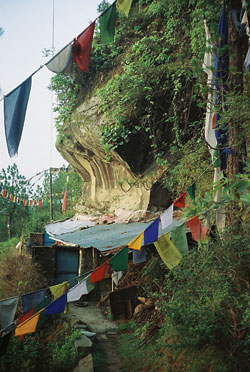
One day, Ani Choe Lhamo shows up to check on me, but I think she wants her cave back and offer to move out. She scowls good-humoredly—I’m being tiresome. The next time she comes, I can’t resist offering again. The truth is, I can’t imagine moving out of my house in Boston for her.
That was the night I had my Hindi spy dream.
As for Ani Choenyi, she’s been waiting on me hand and foot. Buttered chapatis at breakfast, stir-fried vegetables at lunch, piping hot corn porridge at dinner. “Eat, eat,” she cries, ladling a third helping onto my plate. Tea—I must be swilling forty cups a day. Sweet milky Indian tea, Tibetan butter tea, plain black tea (suja, pocha, ngakja in Tibetan). Every afternoon she comes with a cup of suja and a cookie, in case I’m hungry and tired from all my practice.
I have to receive this love. What else am I going to do, go home early and pay a penalty to the airlines?
Ani Choenyi is a Chaucerian character, stout, honest, with a face as rough as the earthen walls. We spend mealtimes laughing, having elaborate conversations in a blend of pantomime and baby-talk Tibetan. She’s taught me many of the things a mother would teach her child. The names and uses of my fingers, for example. First finger: Eating Finger. Middle finger: Ring Finger. Third finger: Secret Finger. Fourth finger: Little Finger. Sticking her two Secret Fingers into her nostrils, she tells me this is a foolproof method of easing childbirth. The baby will pop right out, she assures me, nodding vehemently with her fingers still stuck in.
And, as it often used to happen in those romantic old spiritual books, she’s teaching me things I could learn in no other way, the rhythms of a practitioner who’s in it for the long haul: wake up between three and four a.m. and practice until eight a.m.; take the rat you trapped last night and release it far away (the supply of rats is endless); enjoy a leisurely breakfast, then meditate until lunchtime; after lunch you nap, do chores, or perhaps receive a visitor; then, what? more meditation; dinner is small; then practice until late: ten p.m. Ani Choenyi saw her mother and sister killed by the Chinese. “I went to my teacher, Golok Ani, and I said, ‘Let’s go.’” Golok Ani, the nun from Golok, was her teacher for thirty years, but Ani Choenyi never learned her personal name. The two of them took trains and walked to India. They stopped in Sikkim to see the Nyingma master Dudjom Rinpoche, then in Bodh Gaya, arriving here in 1962. Back in the old days, the hill was “empty,” natural. Villagers said the deep narrow cave at the top of the mountain was where Guru Rinpoche and Mandarava practiced. She and Golok Ani joined the great meditator Wangdor Rinpoche, living in small caves, phuk-pa chum-chum, among the piled rocks. Snow would blow in. Golok Ani died, sitting up in meditation; then Ani Choe Lhamo came along, a new cave-mate.
After Wangdor Rinpoche emerged from his practice, temples were built around him. More refugee practitioners keep arriving. Now there are at least fifty people up here. Most are young nuns from Derge, Wangdor Rinpoche’s region of Tibet. He supports the community as best he can, bringing money back from teaching tours to the U.S. and Europe. He installed electricity and water pipes and donated furry blankets to everyone. But now he’s seventy-two and finds it more difficult to travel. Some of the foreign sponsors got tired of sending money to people they’d never seen. And now that caves are chockablock, the local villagers are reportedly resisting new arrivals.
Back in the old days, Ani Choenyi tells me, it was better, not so crowded. But certainly less convenient. They lugged water from a spring an hour’s walk downhill and begged for food in the villages.
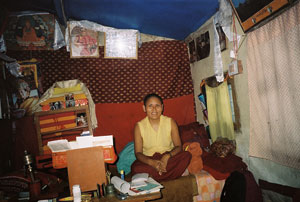
It makes me cry when she talks about how the Indian people helped Tibetans. In the early days, a locket bearing the Dalai Lama’s image was a train ticket, meal ticket, and room for the night. “We owe them everything,” she says simply. Soon I learn from a tea-shop owner that Ani Choenyi put him through school and is now paying for his children’s education. Then there’s Malka, the sad, homeless widow who roams the hillsides, kicked out by her family. She keeps a change of clothes in Ani Choenyi’s woodshed. When the milk seller’s husband gets drunk and beats her, she too pours out her heart to Ani Choenyi.
But Ani Choenyi is no fool; she has what in the West we call “good boundaries.” Time to meditate? She kicks out her friends and locks the gate. One day the tea-shop owner invites her to the christening of a new baby, and Ani Choenyi comes toddling home from the party after half an hour. They were drinking alcohol, she grouses. A nun has no business lingering at that sort of party.
She’s confided in me her opinion of Westerners. The ones she’s met are a little cuckoo. Emotional. “Should I do this practice, or that practice?” she mimicks, guffawing; I wince with recognition.
Today the only reason I’m alone, out on this veranda, is that she’s chanting in a ceremony downtown—a feast offering for an unsuccessful itinerant clothing vendor. Afterward she’ll go to the market and buy food for the two of us. It’s actually funny—I was secretly relieved she’d be away so I could finally skip a meal and eat the chocolate Luna Bar I’d been saving. I told her not to arrange a lunch and she slyly pretended to agree. As soon as I’d gobbled the Luna Bar, there came a shy knock at the blue metal gate. I unbolted it and sure enough, there stood Ani Ngejung from two caves down, holding an enamel plate piled high with rice and eggplant curry. She sat and watched me eat, then silently took the plate away.
After she leaves, I try to meditate indoors. But it’s mid-July, hot season in India. Stuffed and drowsy, I come out where it’s cooler. A flock of warblers dips in and out of the bushes. Soon the mongoose slinks out from behind the water tank, liquid and silent as the snakes it feeds on. Seeing me, it slinks back.
Alas, if I am to embody a Tantric deity, it will be a distracted one.
Downhill a house is being built. Stonemasons’ hammers clink, each blow clear but tiny. Fainter still is the tumult of the pilgrim town. Bus motors grinding, dogs yapping, laughter, shouts, an occasional temple bell. The thousand-meter drop provides a contemplative distance my unruly mind cannot. The worried world looks dollhouse-sized. Leaning forward, I can see the town rimming a button-sized lake. Tibetan gompas with yellow corrugated roofs; the Sikh gurdwara’s powder-blue dorm, the fat white spire of the Hindu mandir.
A shoulder of the mountain hides the new statue of Guru Rinpoche, still mostly imaginary. He grows larger slowly as pilgrims’ coins drop into donation boxes. The completed statue will be eighty-seven meters tall, adding to the magnetism of the lake.
The mayor, who also runs the dry-cleaning shop, tells me that fully half of the local population consists of pilgrims, a stable flux of six thousand. This supports local farmers and shopkeepers. July is the high season, plains dwellers heading for the hills, bringing their children before school has started. All the passes down from Ladakh are open, too. Huge Sikh families are continually disgorged from SUVs, cameras ready to point and shoot at any Westerner. Busloads of Ladakhis—indescribably dirty and devout—come to prostrate in all the gompas. Not to mention the trickle of new Tibetan refugees arriving day by day. And the odd foreigner, like me.
Who must force herself to go back to visualizing her wrathful deity.
He’s squashing me under his big toe. “Rulu, Rulu!” he roars, then disappears into space again, leaving me to my fatuous thoughts.
“Why do people practice in caves?” I ask Tenzin Wangyal Rinpoche, the Bön Buddhist lama, a month after I return to the United States .
He laughs and says that back in Tibet, if you didn’t want to be a nomad or a town dweller any more, the caves were right there. Free housing.
I press him. “Is there an energy in the earth?” Yes, he said, making a circular gesture in front of his belly. But hardly anybody knows how to work with it. Sacred energy is easier—the energy from previous meditators. Your efforts enter a kind of multiplying circuit, enhanced and eased by those who came before you.
It sure feels that way.
Hundreds of colorful prayer flags flutter in the gentle breeze like laundry of the gods. Their shadows dart jerkily, unpredictably in the thin, dried-up thorn branches that edge the nuns’ terrace. This homemade security fence has seemed threatening and unaesthetic up to now, with its inch-long thorns poking through damp grubby laundry, trapping food crumbs from the dishwater Ani Choenyi tosses down the nearly vertical hillside. Suddenly the fence reminds me of a sculpture I saw once in a gallery: a room-sized, impossibly fragile construction made of toothpicks by a Polish artist. Hers lacked the element of movement, this mesmerizing flitting from depth to surface, point to point. I fantasize shipping the whole caboodle to New York, then lapse into a purer contemplation of the ephemeral movements of light. Is anything actually moving? Does the light inherently exist? Is it different from the shadow that follows it so closely? Finally I hear a rattling at the blue gate. Ani Choenyi coming home. I straighten my back, begin to move the mala through my fingers. I’ve missed her; I wouldn’t want her to think I’m slacking off.
In a few days I will leave this sacred place and time. Ani Ngejung will insist on carrying my suitcase on her head all the way to the bus stop. Ani Choenyi will accompany me down, to a restaurant where I’ll treat her and Choe Lhamo to meat momos.
“Come back in two years!” they’ll say. “We’ll set you up in a sealed retreat. Now that we know you, we can really help you!”
Thank you for subscribing to Tricycle! As a nonprofit, we depend on readers like you to keep Buddhist teachings and practices widely available.